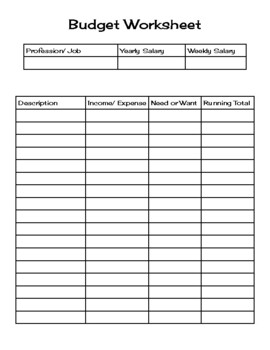- Word Document File
Description
This Budget Worksheet is a great resource to have for Social Studies, Economics, or Finance lessons for younger grades! This activity can be made more challenging or simplyfied to fit your classroom needs! Included is:
- Budget Worksheet for income/ expenses and wants/needs
-24 Suggested professions and salaries (Salaries are based on the national average with some rounding)
How I use this worksheet in my classroom is usually during a personal finance lesson. I randomly assign the students a profession and a salary and then have them practice making choices between wants and needs. You can make this a center by having some wants and needs written down on index cards that the students can go through independently, or you can do a whole class activity by having the wants and needs on index cards placed around the room.





